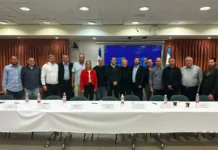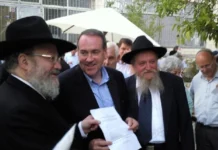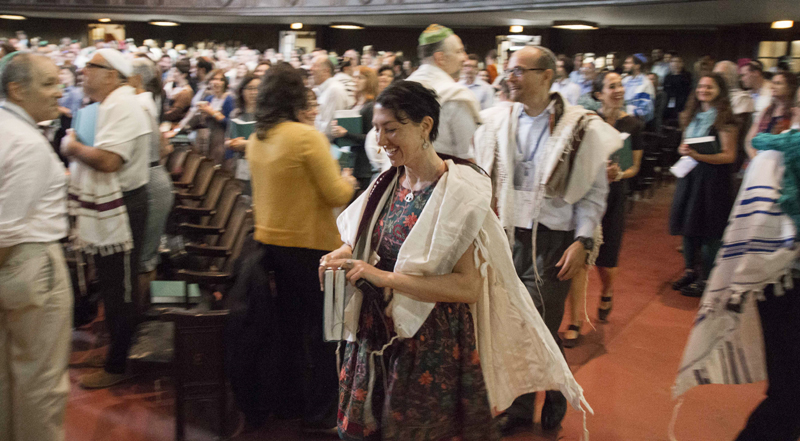It was June 2009, and Rabbi Avi Weiss, along with Bar-Ilan University Professor Daniel Sperber, had just conferred upon Sara Hurwitz the title “Maharat,” a phrase coined by Weiss for “Manhigah Halachatit Ruchanit Toranit,” a female “Torah and spiritual leader.” Hurwitz had completed a course of rabbinical study under Weiss, and Weiss sought to confer upon her a newfangled title that avoided rabbinic verbiage. Six months later, upon realizing that the title “Maharat” was not catching on, Weiss changed Hurwitz’ title to “Rabba,” female rabbi.
Shortly thereafter, the Moetzes Gedolei HaTorah of Agudas Yisroel of America issued a proclamation in response:
“Rabbi Avi Weiss has conferred ‘semikha’ upon a woman, has made her an Assistant Rabbi at the Hebrew Institute of Riverdale where she carries out certain traditional rabbinical functions, and has now given her the title of ‘Rabbah’ (formerly ‘Maharat’). He has stated that the change in title is designed to ‘make it clear that Sara Hurwitz is a full member of our rabbinic staff, a rabbi with the additional quality of a distinct woman’s voice.’
“These developments represent a radical and dangerous departure from Jewish tradition and the mesoras haTorah, and must be condemned in the strongest terms. Any congregation with a woman in a rabbinical position of any sort cannot be considered Orthodox.”
At its annual convention one month later, the Rabbinical Council of America (RCA) issued a resolution that stated in part:
“We cannot accept either the ordination of women or the recognition of women as members of the Orthodox rabbinate, regardless of the title.”
Weiss was at the time a member of the RCA, and he ceded to pressure from the RCA, declaring on March 5, 2010, that no further women would be ordained with a rabbinic title: “After negotiations with the president of the RCA, it is not my intention or the intention of Yeshivat Maharat to confer the title of Rabba upon its graduates.”
Weiss’ commitment – whatever it may or may not have been worth – was temporary and was breached by Weiss, who again began to use rabbinic phraseology regarding graduates of Yeshivat Maharat (and who eventually conferred upon the graduates the titles of “Rabba” and “Rabbi,” along with a full-blown Yoreh-Yoreh semicha klaf). This prompted the RCA in 2013 to issue a second resolution against Weiss and Yeshivat Maharat, which read in part:
“In light of the recent announcement that Yeshivat Maharat will celebrate the ‘ordination as clergy’ of its first three graduates, and in response to the institution’s claim that it ‘is changing the communal landscape by actualizing the potential of Orthodox women as rabbinic leaders,’ the Rabbinical Council of America reasserts its position as articulated in its resolution of April 27, 2010… The RCA views this event as a violation of our mesorah (tradition) and regrets that the leadership of the school has chosen a path that contradicts the norms of our community.”
Weiss did not back down. Pushing full speed ahead, he continued to ordain new women “rabbis” every year, and even though mainstream Orthodox shuls would not hire them, a handful of leftwing shuls, some of whom were led by RCA members and were OU member congregations, did hire these women as clergy in the capacity of assistant rabbis, sometimes using a variety of newly concocted titles (such as “Moratenu” and “Rosh Kehillatenu”). In response, so as to give its prior resolutions some teeth, a group of young RCA members drafted and successfully pushed through a resolution in 2015 that RCA members may not:
Ordain women into the Orthodox rabbinate, regardless of the title used; or
Hire or ratify the hiring of a woman into a rabbinic position at an Orthodox institution; or
Allow a title implying rabbinic ordination to be used by a teacher of Limudei Kodesh in an Orthodox institution.
Even though this resolution is to be credited with a near stoppage of additional RCA members and OU member shuls hiring Open Orthodox female clergy, those congregations that had already retained female clergy scorned and attacked the new RCA resolution, stubborn in their refusal to dismiss their “rabbas.”
The following year, the OU convened a rabbinic panel, headed by Rabbi Hershel Schachter and Rabbi Gedalia Dov Schwartz, and comprised of roshei yeshiva and rabbeim from RIETS (Yeshivas Rabbeinu Yitzchok Elchonon), that would issue guidelines for OU member shuls, so as to put the issue of female clergy in OU member shuls to rest once and for all.
The panel concluded that:
“For the reasons stated above, we believe that a woman should not be appointed to serve in a clergy position. This restriction applies both to the designation of a title for women that connotes the status of a clergy member, as well as to the appointment of women to perform clergy functions on a regular ongoing basis – even when not accompanied by a rabbinic-type title. The spectrum of functions appropriately considered as the role of clergy can be identified by duties generally expected from, and often reserved for, a synagogue rabbi. These common functions include, but are not limited to: the ongoing practice of ruling on a full-range of halakhic matters, officiating at religiously significant life-cycle events…serving as the synagogue’s primary religious mentor, teacher, and spiritual guide. While a synagogue rabbi performs myriad functions, it is these common functions most often performed by a rabbi that characterize his role as the synagogue’s formal religious leader. The gamut of rabbinical responsibilities has evolved over time, adapting to the needs of each generation and locale. Nonetheless, the designated role of spiritual synagogue leader can be identified through the prevailing rabbinic duties.”
Last week, the OU board met and formally adopted the rabbinic panel’s conclusions.
Open Orthodox leadership responded with immediate attack.
Rabbi Shmuel Herzfeld, who, along with Maharat (female clergy) Ruth Balinsky Friedman, leads Open Orthodox Congregation Ohev Sholom in Washington, D.C., lashed forth:
“The OU does not get to define what is Orthodox. The OU statement is horrible.
“These men in the leadership of the OU don’t want to give proper credit and respect to women. When they came to our office, they spoke to the maharats and asked them to change their title. The chutzpah. I feel that there is very weak leadership at the helm of this organization.”
International Rabbinic Fellowship (IRF), which is led by men and women largely affiliated with Yeshivat Chovevei Torah (YCT) and Yeshivat Maharat (YM), the Open Orthodox rabbinical schools, likewise harshly condemned the OU:
“The OU itself has stated that it has chosen the single issue of women’s spiritual leadership to project itself as Orthodoxy’s gatekeeper rather than as its facilitator.
“By choosing to enforce standards that exclude Orthodox colleagues in avodat hakodesh who demonstrate in their work and personal practice a complete commitment to Orthodoxy and halakha, the OU is reversing decades of precedent and goodwill, and enacting bad policy.
“We believe the OU is missing a historic opportunity to truly promote women’s spiritual leadership across the spectrum of our diverse Orthodox community. By doing so, it is squandering its role as a unifying force in the community.”
It is ironic that Herzfeld and IRF label the OU as narrow-minded and excluding others from Orthodoxy, while Herzfeld and IRF conveniently forget that Orthodoxy – Torah – is a set of rules and standards, and is not a piece of Silly Putty that can be defined as one likes and that can be bent into whatever one desires (even though a quick perusal of Open Orthodox practices and beliefs leads one to the inevitable conclusion that this denomination maintains that Orthodoxy is another word for “everything goes.”)
It is ironic that Herzfeld and IRF negate the concept of Orthodox Judaism being anchored in the consensus of halachic rulings by the generation’s most preeminent rabbinic leaders, from the Moetzes, to senior RIETS poskim, and beyond, and instead insist on rabbinic autonomy in the weightiest and most potentially divisive of areas, including who is a Jew and who is a rabbi. YCT and YM leadership have led their denomination down a path of unilateralism and fragmentation, encouraging each rabbi to decide his – and her – own standards. Hence have Open Orthodox clergy penned “teshuvot” that materially reform geirus regulations, shul practices, and much, much more (such as permitting women to serve as chazzan for Selichos, to lain and to receive aliyos, and authorizing people to carry outdoors on Shabbos even without an eruv, and encouraging people to delete the second through fourth brachos of Birchos Hashachar, and allowing people to eat fleishige meals in treife homes).
It is ironic that Herzfeld and IRF accuse the OU of divisiveness, when it is Herzfeld, IRF, and the Open Orthodox denomination that have knowingly and deliberately broken away from mainstream Orthodoxy and consensus halachic practice, knowing that Orthodox leadership did not sanction their radical actions and novel approach to Judaism. Herzfeld nastily said of the OU, “the chutzpah.” I’m afraid that Herzfeld should have rather focused that remark inward.
If this is not a case of the pot calling the kettle black, then I do not know what is.
Let us examine what transpired in years past, when RCA/OU-style Orthodoxy was challenged by various threats to undermine basic halacha and mesorah. We present this for context and example, as these actions proved to be highly effective for the RCA/OU community. Half a century ago, when many otherwise Orthodox shuls were removing their mechitzos, Rabbi Joseph B. Soloveitchik of RIETS directed the RCA to remedy the situation without equivocation, writing in 1954:
“It is completely irrelevant to our problem whether fifty or five percent of the membership of the RCA occupies pulpits in synagogues with improper seating arrangements. The violation of a religious, ethical principle does not affect its validity and cogency even though a large segment of the community is engaged in doing so. A transcendental tenet is binding regardless of its unpopularity with the multitudes. Was the commandment against murder declared null and void while the Nazi hordes were practicing genocide?
“A synagogue with a mixed-seating arrangement forfeits its status of mikdash me’at and is unfit for prayer…
“Any rabbi or scholar who attempts to sanction the desecrated synagogue, ipso facto casts doubt on his own moral right to function as a teacher or spiritual leader and legalize, or even apologetically explain, this basic deviation (of a shul with mixed seating).
“In my opinion. the halakhic dictum of … ‘yehareg v’al ya’avor,’ requiring of us a heroic stand in times of adversity, applies not only to political and religious persecution originated by some pagan ruler, but also to situations in which a small number of God-fearing and Torah loyal people is confronted with a hostile attitude on the part of the majority dominated by a false philosophy.
“The Rabbinical Council of America stands now at the crossroads, and must decide to either assume boldly and courageously the time-honored, by-ages-sanctified role of the traditional rabbinate which traces its history back to Joshua, Moses and Sinai, and thus be ready to fight for an undiluted halakhah which is not often in the vogue, or to deteriorate into a so-called modern rabbinic group of undefined quality and of a confused ideology, vague in its attitude and undecided in is policies…
“I call on the convention to make its stand clear on this problem, and to break finally with the policy of evading issues and employing ambiguities and inconsistencies. Matters have gone too far…”
Similarly, half a century ago, during an era when some Orthodox shuls were entertaining the use of microphones on Shabbos – a practice associated with the Conservative and Reform movements – the Agudas Harabbonim in 1951 and Rabbi Soloveitchik in 1954, upon his assuming leadership of the RCA’s Halacha Commission, both firmly declared microphone use unacceptable for Shabbos. That totally ended further Orthodox shul engagement with microphones and established the issue as a clear fault line that separated Orthodoxy from non-Orthodoxy.
In 1964, while the Roman Catholic Church had convened the Second Vatican Council and expressed a desire to warm up to the Jews and engage in interfaith dialogue, Rabbi Soloveitchik advised the RCA that such dialogue was not permitted. This immediately became binding policy for the RCA and the OU. After addressing the issue in his famous essay “Confrontation,” Rabbi Soloveitchik wrote to the RCA:
“We are, therefore, opposed to any public debate, dialogue or symposium concerning the doctrinal, dogmatic or ritual aspects of our faith vis-à-vis ‘similar’ aspects of another faith community. We believe in and are committed to our Maker in a specific manner and we will not question, defend, offer apologies, analyze or rationalize our faith in dialogues centered about these ‘private’ topics which express our personal relationship to the God of Israel.”
(In contrast, a large contingency of Open Orthodox clergy on December 3, 2015, issued its “Orthodox Statement on Christianity,” in which it declared: “We acknowledge that the emergence of Christianity in human history is neither an accident nor an error, but the willed divine outcome and gift to the nations… We Jews can acknowledge the ongoing constructive validity of Christianity as our partner in world redemption… Both Jews and Christians have a common covenantal mission to perfect the world under the sovereignty of the Almighty, so that all humanity will call on His name and abominations will be removed from the earth… In imitating G-d, Jews and Christians must offer models of service, unconditional love and holiness. We are all created in G-d’s Holy Image, and Jews and Christians will remain dedicated to the Covenant by playing an active role together in redeeming the world.” And news reports stated: “‘The real importance of this Orthodox statement is that it calls for fraternal partnership between Jewish and Christian religious leaders, while also acknowledging the positive theological status of the Christian faith. Jews and Christians must be in the forefront of teaching basic moral values to the world,’ said Rabbi Shlomo Riskin, one of the statement’s initiators.” This Open Orthodox initiative represents a total rejection and repudiation of Rabbi Soloveitchik’s and the RCA’s policy, and it embodies an acknowledgment of the sanctity of avodah zarah.)
In 1975, when Rabbi Emanuel Rackman suggested nullifying marriages without a get by use of a novel mechanism that would undo one of the chazakos of the Gemara, in light of modern psychology, Rabbi Soloveitchik forcefully shot down Rackman’s proposal at the RCA convention:
“I want to be frank and open. Do you expect to survive as Orthodox rabbis? Do you expect to carry on the mesorah under such circumstances? I hope that those who are present will join me in simply objecting to such symposia and to such discussion and debate at the Rabbinical Convention.
“To speak about changing the halachos of Chazal is, of course, at least as nonsensical as discussions about communism at the Republican National Convention. It is discussing self-destruction, a method of self-destruction and suicide. I know; you don’t have to tell it to me – b’sochacha ani yoshev – I don’t live in an ivory tower or in a fool’s paradise. I know that modern life is very complex. I know your problems; many of them are passed on to me. We are confronted with horrible problems – social, political, cultural, and economic – problems of the family, of the community, and of the society in general. We feel, and I sometimes feel like you, as if we are swimming against the tide; the tide is moving rapidly, with tremendous force, in the direction opposite of the way in which we are going. I feel it; I know it; you don’t have to tell it to me. The crowd, the great majority, has deserted us, and cares for nothing. I know the danger of taaruvos (mixtures) of weddings, of church weddings, in which a Jew or a Jewess is united in marriage by a priest and some Reform rabbi. We are facing an awesome challenge, and I am mindful of all that. However, if you think that the solution lies in the reformist philosophy, or in an extraneous interpretation of the halachah, you are badly mistaken.“This is Toras Moshe; this is surrender (to Hashem); this is Kabbolas Ol Malchus Shomayim. We surrender. The Torah summons the Jew to live halachically. We cannot allow an aishes ish (married woman), no matter how tragic the case, to remarry without a get. We cannot permit a giyores to marry a kohein, and sometimes the cases are very tragic, as I know from my own experience. I had a case in Rochester: a gentile girl became a giyores before she met the boy. She was a real giyores hatzedek; she did not join our fold because she wanted to marry somebody. Then she met a Jewish boy… He had absolutely no knowledge of Yahadus; she brought him close to Yahadus. They got engaged, and he visited the cemetery. Since he had come closer to Yahadus, he wanted to find out about his family, about his family tree, so he visited the cemetery in which his grandfather was buried, and he saw a strange symbol – ten fingers. So they began to ask – they thought it was a mystical symbol, and then they discovered that he is a kohein. What can you do? This is the halachah – the kohein is assur to the giyores. We surrender to the will of the Almighty.
“I come from a rabbinic house; it is called Bais HoRav, the house into which I was born, and believe me, Reb Chaim used to try his best to be a meikil (lenient). However, there were limits even to Reb Chaim’s skills. When you reach the boundary line, it is all you can say – ‘I surrender to the will of the Almighty.’ This is a sadness in my heart, and I share in the suffering of the poor woman, who was instrumental in bringing him back to the fold, and then she had to lose him; she lost him; she walked away.
“This is why the Rambam says that Talmud Torah is identical to Kabbolas Ol Malchus Shomayim, and to speak about halachah as a fossil, Rachmana litzlon, is ridiculous. Because we know, those who study halachah know, it is a living, dynamic discipline that was given to man in order to redeem him and to save him. We are opposed to shinuyim (changes) of course, but chiddush is certainly the very essence of halachah. There are no shinuyim in halachah, but there are great chiddushim. But the chiddushim are within the system, not from the outside. “You cannot pychologize halachah, historicize halachah, or rationalize halachah, because this is something foreign, something extraneous. As a matter of fact, not only halachah – can you psychologize mathematics? I will ask you a question about mathematics – let us take Euclidian geometry. I cannot give many psychological reasons why Euclid said two parallels do not cross, or why the shortest distance between two points is a straight line. If I were a psychologist, I could not interpret it in psychological terms. Would it change the postulate, the mathematical postulate? And when it comes to Torah, which is Hakadosh Boruch Hu, all the instruments of psychology and history, utilitarian morality, are being used to undermine the very authority of the halachah.”
Open Orthodoxy has waged an unrelenting campaign to reform Torah, willfully disregarding and trampling on rabbinic authority and mesorah, in a suicidal trajectory to bring Torah in line with liberal, secular values and to affirm “rabbinic autonomy,” so that each rabbi can do whatever he wants without concern for the words of senior poskim and chachmei hador. The only way to counter this reckless movement and shield Torah life and values from onslaught by Open Orthodox “rabbis” and “rabbas” who make up their religion as they go along is to align ourselves with the chachmei haTorah of every generation and to recognize that Torah is bound by mesorah, which is unchanging and eternal.
The tzibbur should be aware of a few very recent examples of Open Orthodox recklessness, which have not been publicized in the Orthodox media – until now.
Rabbi Haim Ovadia of Rockville, MD, is the Open Orthodox “chacham” who penned the aforementioned “teshuvot” that permit carrying outdoors on Shabbos without an eruv (based on a controversial unpublished letter from an obscure rabbi in North Africa) and that permit one to eat even meat dishes in a treife home (based on a gross misunderstanding of a p’sak from Rav Moshe Feinstein). In addition to his exceedingly errant and cavalier “p’sakim,” Ovadia has written that which cannot be called anything other than kefirah.
In a February 2, 2017 article titled “Divine Justice and Personal Responsibility” published in Kol HaBirah, Ovadia wrote:
“Why then do we read in the Bible that G-d micromanages our life? It was written for marketing purposes. No one would have accepted the weird new religion which denounced idolatry, claimed that all humans were created in the image of an invisible G-d, mandated a day of complete rest, and expected masters to treat their slaves as human beings. The idea that if you do all these you will be rewarded with bliss and abundance, and that if not, fire and brimstone will turn your cities into Sodom and Gomorrah, was the powerful incentive that brought followers to the new religion.”
In other words, the concept of s’char v’onesh as articulated in the Torah is false, according to Ovadia, and was written there “for marketing purposes” (!).
But there is more. Open Orthodox celebrity Rabbi Shmuly Yanklowitz, who supports to’eivahmarriage, is open to intermarriage, has denied in writing the idea of Moshiach, has written that the Torah is not pure truth and contains evil, and has written that he is against having a third Bais Hamikdosh, recently accompanied Ovadia on a “gerut campaign,” in which Ovadia and Yanklowitz “converted” dozens of people per day. Aside from the obvious concerns of pesul, Yanklowitz was not born Jewish, and he claims to be a ger – although his status as a ger has not been substantiated, as Yanklowitz has not divulged the identity of the bais din he claims oversaw his conversion.
Another team of three Open Orthodox “rabbis” just completed a mass conversion campaign in Latin America, supervising the geirus of dozens of people and then being mesader kiddushin for many of them. These “rabbis” include a YCT administrator who davens at a “partnership minyan” (where men and women take turns laining and leading the davening), a shul rabbi who employs a “Maharat,” and a Mexican rabbi who has called on the Rabbanut to accept people who underwent conversions by Conservative rabbis. Shomu shomayim.
This is hefkeirus and churban. This is the latest damage that Open Orthodoxy is wreaking.
Torah is not a book that is subject to open interpretation and poetic license. It is, rather, a system of avodas Hashem, whose interpretation and application have been entrusted to each generation’s masters of halacha and mesorah, and Hashem has instructed us to heed their hadrochoh.
The battles for Torah truth will continue until Yemos HaMoshiach, but let us recommit ourselves to the Ribbono Shel Olam and accept Torah through a rich and unconditional sense of mesorah, l’ahavoh uleyiroh es Shemecha.


























